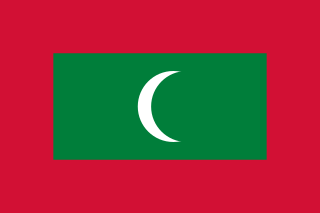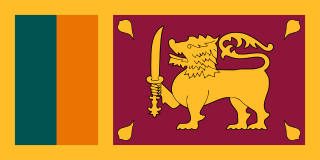
The culture of the Maldives is derived from a number of sources, the most important of which is its proximity to the shores of Sri Lanka and South India. The population is mainly Indo-Aryan from the anthropological point of view.

Cuisine of the Indian subcontinent includes the cuisines from the Indian subcontinent comprising the traditional cuisines from Bangladesh, Bhutan, India, the Maldives, Nepal, Pakistan and Sri Lanka.
Several Dhivehi scripts have been used by Maldivians during their history. The early Dhivehi scripts fell into the abugida category, while the more recent Taana has characteristics of both an abugida and ha true alphabet. An ancient form of Nagari script, as well as the Arabic and Latin scripts, have also been extensively used in the Maldives, but with a more restricted function. Latin was official only during a very brief period of the Islands' history.
Mahl or MAHL may refer to:

The 1988 Maldives coup d'état was the attempt by a group of Maldivians led by Abdullah Luthufi and assisted by armed mercenaries of a Tamil secessionist organisation from Sri Lanka, the People's Liberation Organisation of Tamil Eelam (PLOTE), to overthrow the government in the island republic of Maldives. The coup d'état failed due to the intervention of the Indian Army, whose military operations efforts were code-named Operation Cactus by the Indian Armed Forces.

Rihaakuru is a fish-based thick paste. The color varies from light brown to dark brown. It is a traditional dish of Maldivian cuisine, consumed almost daily in every household in Maldives and in Minicoy since ancient times. Rihaakuru is produced as a by-product of the processing of tuna.

Maldive fish is cured tuna fish traditionally produced in Maldives. It is a staple of the Maldivian cuisine, Sri Lankan cuisine, as well as the cuisine of the Southern Indian states and territories of Lakshadweep, Kerala and Tamil Nadu, and in the past it was one of the main exports from Maldives to Sri Lanka, where it is known as masikaruvaduumbalakaḍa (උම්බලකඩ).

Buddhism in the Maldives was the predominant religion at least until the 12th century CE. It is not clear how Buddhism was introduced into the islands.

Maldives – United States relations are bilateral relations between the Maldives and the United States.

India–Maldives relations refer to the bilateral relations between India and Maldives. Relations have been friendly and close in strategic, economic and military cooperation. India contributed to maintaining security on the island nation.

Air Lanka Flight 512 was an Air Lanka flight from London Gatwick Airport via Zurich and Dubai to Colombo and Malé, Maldives. On 3 May 1986, the Lockheed L-1011 Tristar serving the flight was on the ground in Colombo, about to fly on to Malé, when an explosion ripped the aircraft in two, destroying it. Flight 512 carried mainly French, West German, British and Japanese tourists; 21 people were killed on the aircraft, including 3 British, 2 West German, 3 French, 2 Japanese, 2 Maldivians and 1 Pakistani; 41 people were injured.
Maldivians, also called Maldive Islanders, are a nation and ethnic group native to the historic region of the Maldive Islands comprising what is now the Republic of Maldives and the island of Minicoy in Union Territory of Lakshadweep, India. All Maldivians share the same culture and speak the Maldivian language which is a member of the southern group of Indo-Aryan languages. For ethnographic and linguistic purposes as well as geo-political reasons, anthropologists divide the Maldivian people into 3 subgroups:

Xavier Romero Frías is a Spanish writer and scholar. He lived among the Maldivians over a 13-year period. His present residence is in Bangkok, Thailand.

Maldives–Sri Lanka relations, or official and economic relations between the neighbouring Indian Ocean countries of the Maldives and Sri Lanka, have been positive since the Maldives became independent in 1965. The Maldives first established a mission in Sri Lanka in July 1965, and today has an embassy in Colombo. Sri Lanka has an embassy in Malé. Both countries were founding members of the South Asian Association for Regional Cooperation (SAARC) in December 1985.

Maldivian, also known as Dhivehi or Divehi, is an Indo-Aryan language spoken in the South Asian island country of the Maldives; it is the language of the Maldivians, an Indo-Aryan ethnic group native to the country. It is also the first language of nearly 10,000 people on the island of Minicoy in the Union territory of Lakshadweep, India, where the Mahl dialect of the Maldivian language is spoken.

Among the dialects of Maldivian language, the Mahl dialect has something extra in the writing system. Like the communities speaking other dialects, among the speakers of this dialect too the Thaana alphabet is used in common for writing. However, it was secession of Minicoy from Maldivian rule and affiliating with India which have resulted in the importation of some additional features to the dialect as well as writing system of the Minicoyans.
Indians in Sri Lanka refer to Indians or people of Indian ancestry living in Sri Lanka, such as the Indian Tamils of Sri Lanka.
Mahl people refers to the ethnic Maldivians of India. They are one of the three subgroups of the Maldivians and speak the Mahl dialect of Divehi which is a member of the southern group of Indo-Aryan languages. All Mahls are native to Minicoy Island in the Union territory of Lakshadweep, India, which was formerly a part of the Maldive Islands.
There are over 5,000 expatriates from the Maldives who live in India, in what is recorded as the second largest population of Maldivians living abroad after Sri Lanka. They mostly travel to the nearest Indian city and capital of Kerala, Thiruvananthapuram, for educational and health facilities.

The Maldivian diaspora refers to the community of Maldivians, speakers of the Maldivian language, who have either emigrated from the Republic of Maldives or grew up outside of the Maldives speaking Dhivehi as a first language. The Republic of Maldives is a South Asian country geographically located in the Indian Ocean and Arabian Sea. Maldivians have historically emigrated from the Maldives for numerous reasons including low economic opportunity, political repression, environmental instability, and education. India and Sri Lanka currently host the most Maldivians living outside of the Maldives, but other diaspora communities can be found in Malaysia, Singapore, Pakistan, and Australia.















